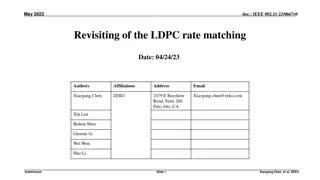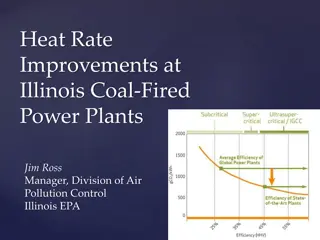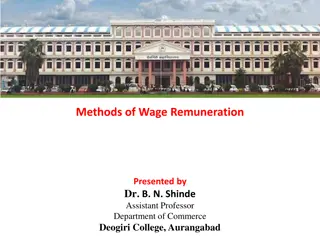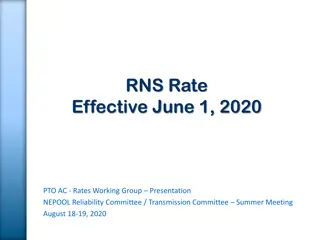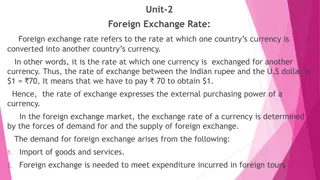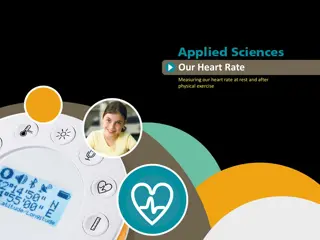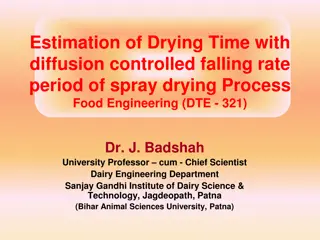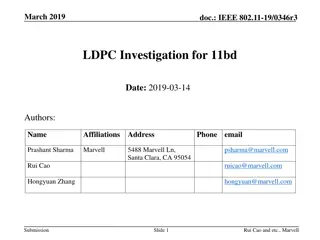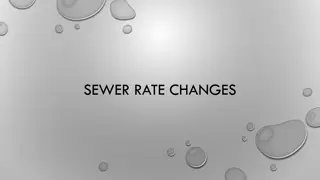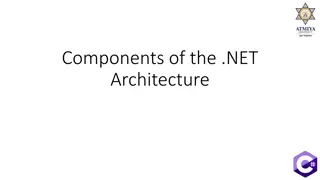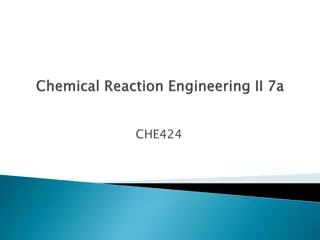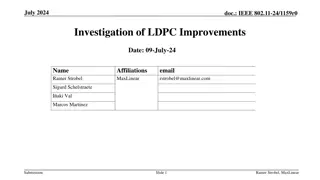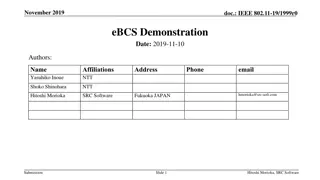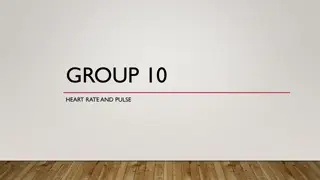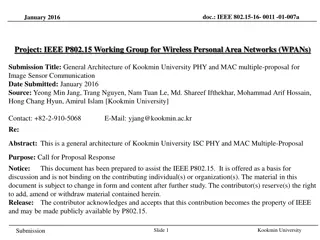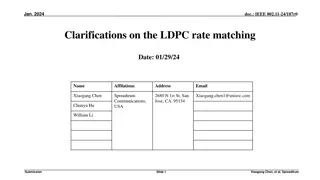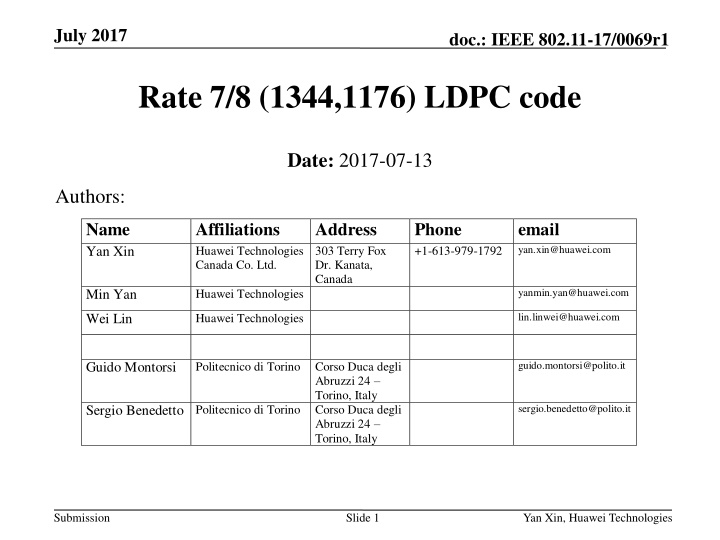
IEEE 802.11-17/0069r1 Rate 7/8 LDPC Code July 2017 Document
"Explore the development of longer LDPC codes with codeword length N=1344 for various rates in the IEEE 802.11 standard. The document discusses performance gains, implementation considerations, and comparisons with existing codes, providing insights into rate 7/8 codes. Delve into the complexities of LDPC coding in wireless communication systems."
Download Presentation

Please find below an Image/Link to download the presentation.
The content on the website is provided AS IS for your information and personal use only. It may not be sold, licensed, or shared on other websites without obtaining consent from the author. If you encounter any issues during the download, it is possible that the publisher has removed the file from their server.
You are allowed to download the files provided on this website for personal or commercial use, subject to the condition that they are used lawfully. All files are the property of their respective owners.
The content on the website is provided AS IS for your information and personal use only. It may not be sold, licensed, or shared on other websites without obtaining consent from the author.
E N D
Presentation Transcript
July 2017 doc.: IEEE 802.11-17/0069r1 Rate 7/8 (1344,1176) LDPC code Date: 2017-07-13 Authors: Name Yan Xin Affiliations Huawei Technologies Canada Co. Ltd. Address 303 Terry Fox Dr. Kanata, Canada Phone +1-613-979-1792 email yan.xin@huawei.com Min Yan Huawei Technologies yanmin.yan@huawei.com Wei Lin Huawei Technologies lin.linwei@huawei.com Guido Montorsi Politecnico di Torino guido.montorsi@polito.it Corso Duca degli Abruzzi 24 Torino, Italy Corso Duca degli Abruzzi 24 Torino, Italy Sergio Benedetto Politecnico di Torino sergio.benedetto@polito.it Submission Slide 1 Yan Xin, Huawei Technologies
July 2017 doc.: IEEE 802.11-17/0069r1 Background Longer LDPC codes with codeword length N=1344 (denoted as 1344-LDPC) for rates 1/2, 5/8, 3/4, and 13/16 [1] have been included in Draft P802.11ay_D0.3 [2]. Performance evaluation shows that for a given code rate, a longer code has ~1dB gain compared to the corresponding short code of length 672 (denoted as 672-LDPC) of the same rates [1]. A short code of length 624 for rate 7/8 obtained by puncturing 11ad 13/16 672-LDPC is adopted in 802.11REVmc [3]. The punctured code is introduced for implementation without changing the core of decoder at a receiver. However, the punctured code has different codeword length as other 11ad codes resulting in impacts on the coding efficiency and the implementation in both transmitter and receiver. Another short code of length 672 for rate 7/8 is proposed [4] and has been included in D0.3 [2]. Following the same methodology as the short code, the rate 7/8 punctured long LDPC code is proposed [1]. However, the codeword length of this punctured code is N=1248 (denoted as 1248-LDPC), which is different from all other long codes for 11ay. This contribution is to introduce a rate 7/8 1344-LDPC code with design by taking into account performance and implementation in decoding, padding and blocking. Submission Slide 2 Yan Xin, Huawei Technologies
July 2017 May 2015 doc.: IEEE 802.11-17/0069r1 Outline Review of long code proposed in [1] Discussion of the blocking issue with different codeword lengths Performance comparison Discussion of decoding complexity Summary Submission Slide 3 Yan Xin, Huawei Technologies
July 2017 May 2015 Rate 13/16 LDPC codes in 11ad and for 11ay doc.: IEEE 802.11-17/0069r1 Rate 13/16 672-LDPC code in 11ad [7] (matrix H 126 x 672, Z = 42) 29 37 25 30 31 22 0 8 33 11 31 22 21 3 17 6 14 4 27 32 4 28 9 2 20 12 14 27 29 18 24 10 13 23 0 13 18 4 23 34 20 15 13 22 24 Rate 13/16 1344-LDPC code for 11ay [1] (matrix H 252 x 1344, Z = 42) 1 0 1 0 0 0 1 0 1 1 0 1 1 0 0 1 1 1 0 0 0 0 0 1 1 0 0 1 0 0 0 0 1 1 1 0 1 1 1 0 1 0 Lifting matrix 0 0 0 Submission Slide 4 Yan Xin, Huawei Technologies
July 2017 May 2015 doc.: IEEE 802.11-17/0069r1 Rate 7/8 1248-LDPC code proposed for 11ay [1] Rate 7/8 (1248, 1092)LDPC code is derived by puncturing the first 96 parity bits of the rate 13/16 (1344, 1092) LDPC code. Transmitter does not transmit the punctured bits; receiver set log-likelihood ratios to zero for these bits. The codeword length of this rate 7/8 LDPC code generated through puncturing is 1248 (rather than 1344 as other LDPC codes [1] proposed for 802.11ay). The decoding complexity of this 7/8 code is similar to the 13/16 code with additional procedure to insert zero LLR value at the punctured positions before performing decoding. As shown in the following slides, the rate 7/8 code generated using puncturing increases the redundancy (padding more zeros during encoding and SC blocking in most cases evaluated below) and increases the complexity of SC blocking. Submission Slide 5 Yan Xin, Huawei Technologies
July 2017 Rate 3/4 LDPC codes in 11ad and for 11ay Rate 3/4 672-LDPC code in 11ad [7] (matrix H = 168 rows x 672 columns, Z = 42) doc.: IEEE 802.11-17/0069r1 May 2015 41 35 41 35 35 29 37 25 19 30 31 22 41 0 18 4 22 8 23 34 40 33 11 31 41 22 21 3 39 17 6 14 6 4 28 27 32 4 18 28 9 17 20 12 14 3 28 24 27 29 18 23 0 13 20 15 13 22 13 24 Rate 3/4 1344-LDPC code for 11ay [1] (matrix H = 336 x 1344, Z = 42) 0 0 1 1 1 0 0 1 0 0 1 1 0 Lifting matrix 1 0 1 0 0 0 1 0 1 1 0 1 1 0 0 1 1 1 0 0 0 0 0 1 1 0 0 1 0 0 0 1 1 1 0 1 0 1 0 0 0 1 0 35 19 41 22 40 41 39 6 28 18 17 3 28 35 29 30 19 41 22 40 41 22 17 39 6 4 28 27 18 17 28 20 3 28 24 23 0 8 33 27 Code matrix 29 37 30 0 8 33 11 22 17 4 27 32 28 9 20 27 24 23 0 31 18 23 21 6 20 12 29 13 37 25 22 31 18 4 23 34 31 11 21 6 20 15 32 9 12 29 14 18 0 13 3 14 4 13 13 22 24 25 22 4 34 31 3 14 15 4 14 18 13 13 22 24 Submission Slide 6 Yan Xin, Huawei Technologies
July 2017 May 2015 doc.: IEEE 802.11-17/0069r1 Rate 7/8 1344-LDPC code proposed for 11ay Generation of the rate 7/8 1344-LDPC code based on the 11ad rate 3/4 672-LDPC code (complementary): - Find an optimal lifting matrix (by search to yield the best error rate performance) to be applied to the 11ad 3/4 672-LDPC code matrix. The optimal lifting matrix is shown as below. 1 1 0 0 0 0 0 1 1 0 1 0 0 Row #1 #2 #3 #4 1 0 0 0 0 1 0 1 1 1 1 0 1 1 0 1 1 0 1 1 0 1 0 0 1 0 0 1 1 1 0 0 0 1 1 1 1 0 0 1 0 0 0 Rows #1 and #3 as well as Row #2 and #4 are complementary. - Applying the optimal lifting matrix to the 11ad rate 3/4 672-LDPC code matrix yields: 35 19 41 22 40 41 35 19 41 22 40 29 30 0 8 33 29 30 0 8 33 22 37 31 18 23 11 37 31 18 23 11 21 25 22 4 34 31 3 25 22 4 34 31 #8 39 6 28 18 17 3 28 Row #1 41 22 39 17 6 28 18 17 28 3 28 24 #2 #3 #4 #5 #6 #7 4 27 20 27 23 17 4 27 32 28 20 12 27 24 29 23 0 21 6 20 9 13 6 20 32 9 12 29 0 13 22 14 15 4 14 18 13 13 24 3 14 15 4 14 18 13 13 22 24 - Summing the 1st& 5th, 2nd&6th, 3rd&7th and 4th&8th rows of the matrix 336 rows x 1344 columns, Z=42 above results in the rate 7/8 (1344, 1176) LDPC code matrix (168 rows x 1344 columns, Z=42): 37 35 31 19 41 18 22 23 40 11 41 21 39 6 20 35 37 19 31 18 41 23 22 11 40 21 41 6 39 6 25 29 30 22 0 4 34 8 31 33 3 22 14 17 15 29 25 22 30 4 0 8 34 33 31 22 3 17 14 4 32 28 18 20 28 32 4 4 15 27 6 9 12 17 3 29 28 3 0 13 9 18 17 12 29 28 14 20 27 18 13 24 13 23 22 20 14 18 27 24 13 23 13 28 0 13 27 4 24 28 22 24 Submission Slide 7 Yan Xin, Huawei Technologies
July 2017 May 2015 doc.: IEEE 802.11-17/0069r1 SC Blocking for the 1344-LDPC code and the 1248-LDPC code (QPSK, SC block length of 448) SC QPSK blocking for codeword length 1344 SC QPSK blocking for codeword length 1248 Source word1 Source word2 Source word1 Source word2 Source word28 Encoding Encoding Codeword1 Codeword2 Codeword1 Codeword2 Codeword28 (bits) (bits) 1344 1344 1248 1248 1248 Bit-to-symbol mapping Bit-to-symbol mapping Codeword1 Codeword2 Codeword1 Codeword2 Codeword28 672 672 (symbols) 624 624 624 (symbols) Blocking Blocking BLK 1 BLK 2 BLK 3 BLK 39 BLK 1 BLK 2 (symbols) 448 448 448 448 448 (symbols) Note: Every 39 blocks are constructed from 28 codewords (Each block is constructed from 1 or 2 codewords.) 448 Note: Every 3 SC blocks are constructed from 2 codewords (Each block is constructed from 1 or 2 codewords.) Submission Slide 8 Yan Xin, Huawei Technologies
July 2017 May 2015 SC Blocking for the 1344-LDPC code and the 1248-LDPC code (16QAM, SC block length of 448) doc.: IEEE 802.11-17/0069r1 SC 16QAM blocking with codeword length 1248 SC 16QAM blocking with codeword length 1344 Source word1 Source word2 Source word3 Source word4 Source word1 Source word2 Source word56 Encoding Encoding Codeword3 Codeword1 Codeword2 Codeword4 Codeword56 Codeword1 Codeword2 (bits) 1344 1344 1344 1344 (bits) 1248 1248 1248 Bit-to-symbol mapping Bit-to-symbol mapping Codeword1 Codeword2 Codeword3 Codeword4 Codeword1 Codeword2 Codeword56 336 336 336 336 (symbols) 312 312 312 (symbols) Blocking Blocking BLK 1 BLK 2 BLK 3 BLK 1 BLK 2 BLK 39 (symbols) 448 448 448 448 448 448 (symbols) Note: Every 39 blocks are constructed from 56 codewords. (each block is constructed from 2 or 3 codewords.) Note: Every 3 blocks are constructed from 4 codewords. (each block is constructed from 2 codewords) Submission Slide 9 Yan Xin, Huawei Technologies
July 2017 May 2015 SC Blocking for the 1344-LDPC code and the 1248-LDPC code (64QAM, SC block length of 448) doc.: IEEE 802.11-17/0069r1 SC 64QAM blocking with codeword length 1248 SC 64QAM blocking with codeword length 1344 Source word1 Source word2 Source word28 Source word1 Source word2 encoding Encoding Codeword1 Codeword2 Codeword28 Codeword1 Codeword2 (bits) 1248 1248 1248 (bits) 1344 1344 Bit-to-symbol mapping Bit-to-symbol mapping Codeword1 Codeword2 Codeword28 Codeword1 Codeword2 208 208 208 (symbols) (symbols) 224 224 blocking BLK 1 BLK 2 BLK 13 BLK Blocking 448 448 448 (symbols) (symbols) 448 Note: Every 13 blocks are constructed from 28 codewords (each block is constructed from 3 or 4 codewords ) Note: Each block is constructed from 2 codewords. Submission Slide 10 Yan Xin, Huawei Technologies
July 2017 May 2015 doc.: IEEE 802.11-17/0069r1 Efficiency comparison Number of symbol block padding bits (regular / puncturing) (rate 7/8, codeword length 1344/1248, block length=448) & blocking overhead (1344/1248) (%) QPSK 16QAM 0 / 384 (0% / 7.1%) (0% / 7.1%) 448 / 768 (0% / 7.1%) (12.5%/7.1%) 0 / 640 (0% / 3.1%) (4.5% / 7.1%) 0 / 736 (0% / 1.9%) (0% / 1.9%) 0 / 32 (0% / 0.04%) (0% / 1.2%) 0 / 416 (0% / 0.3%) (0% / 0.9%) Data length (bytes) Data length (bytes) Number of data padding bits (regular / puncturing) (rate 7/8, codeword length 1344/1248) & overhead for coding (1344/1248) (%) 64QAM 0 / 384 (0% / 7.1%) 1344 / 768 (12.5%/7.1%) 0 / 1536 (0% / 7.1%) 0 / 1632 (0% / 4%) 0 / 1824 (0% / 2.3%) 0 / 2208 (0% / 1.4%) 512 0 / 384 512 608 / 272 (12.9%/6.2%) 1024 40 / 544 (0.5% / 6.2%) 1024 1344 / 768 2048 80 / 1088 (0.5% / 6.2%) 2048 896 / 1536 4096 160 / 1084 (0.5% / 3.2%) 4096 0 / 736 8192 320 / 1076 (0.5% / 1.6%) 16384 640 / 1060 (0.5% / 0.8%) 8192 0 / 928 16384 0 / 1312 Submission Slide 11 Yan Xin, Huawei Technologies
July 2017 May 2015 doc.: IEEE 802.11-17/0069r1 Simulation In the following slides, simulated packet error rate performance is compared among the rate 7/8 1344-LDPC code proposed in this contribution, the rate 7/8 1248-LDPC code shown in [1] and the rate 7/8 672-LDPC code [4]. The simulations refer to QPSK, 16-QAM and 64-QAM. AWGN, 11ad conference room channel model. The LDPC decoder is a layered decoder using 8 iterations. Data packet length 4096 bytes. No hardware impairments. Ideal channel estimation. MMSE equalization. Submission Slide 12 Yan Xin, Huawei Technologies
July 2017 May 2015 doc.: IEEE 802.11-17/0069r1 PER (AWGN) Submission Slide 13 Yan Xin, Huawei Technologies
July 2017 May 2015 doc.: IEEE 802.11-17/0069r1 PER (11ad conf. room) Submission Slide 14 Yan Xin, Huawei Technologies
July 2017 PER comparison of rate 7/8 LDPC codes doc.: IEEE 802.11-17/0069r1 May 2015 Consider the performance of the punctured code 1248-LDPC code as the reference. The performance gains (in dB) at 1% PER of various 7/8 LDPC codes are summarized below. AWGN 1344-LDPC 672-LDPC [4] QPSK 0.17 -0.46 16QAM 0.27 -0.58 64QAM 0.21 -0.35 11ad conference room 1344-LDPC QPSK 0.29 16QAM 0.31 64QAM 0.77 Submission Slide 15 Yan Xin, Huawei Technologies
July 2017 May 2015 doc.: IEEE 802.11-17/0069r1 LDPC Decoder Complexity The H matrix of 1344-LDPC code proposed in this contribution is composed of 42x42 single diagonal non-zero or null sub-matrix as the rate 3/4 code in 11ad. 32 single diagonal submatrices per row 37 35 31 19 41 18 22 23 40 11 41 21 39 35 37 19 31 18 41 23 22 11 40 21 41 25 29 30 22 0 4 34 29 25 22 30 4 0 8 6 20 6 32 28 18 20 28 32 4 4 15 27 6 9 12 17 3 29 28 3 0 13 6 39 9 18 17 12 29 28 14 20 27 18 13 24 13 23 22 20 14 18 27 24 13 23 13 28 0 13 8 31 33 3 22 14 17 15 3 17 14 27 4 24 34 33 31 22 4 28 22 24 based on the check node message; - for each layer the check node message is calculated from 32 variable node message. 2) macro-layer decoding: one macro-layer consists two sub-layers. Each sub-layer corresponds to 16 variables the same as a layer of the original 11ad rate 3/4 LDPC code with modification in mapping between check nodes and variable nodes (this is also required for rate 3/4 1344-LDPC). - within each sub-layer the variables can be updated as done in an 11ad LDPC decoder. Variables for each sub-layer can be processed independently. Two sub-layers can process in parallel. - for each macro-layer, with the min-sum decoding algorithm the check node message is calculated by combining the results including one sign and one min value for each sub-layer. - the LLR values can be updated macro-layer after macro-layer, and the process of 16 variables per check node is kept unchanged for each sub-layer. 1) layered decoding: as for a common QC LDPC code - each layer (check node) corresponds to 32 variables which can be updated independently Submission Slide 16 Yan Xin, Huawei Technologies
July 2017 doc.: IEEE 802.11-17/0069r1 Summary Reviewed the design of rate 7/8 long LDPC codes [1] proposed for 11ay. Evaluated the PER performance of the proposed rate 7/8 1344-LDPC code and the punctured 1248-LDPC code. The performance of the proposed 1344-LDPC code is up to 0.77 dB better than the punctured 1248-LDPC code [1]. Analyzed the implementation on symbol blocking for different codeword lengths. The rate 7/8 1344-LDPC codes preserves the codeword length unchanged as other relatively lower-rate codes proposed for 11ay and demonstrate benefits with small granularity in mapping between codewords and single carrier symbol blocks as well as with less redundancy to be added during encoding and symbol blocking (for relative long packets). Discussed decoding complexity. - Decoding of the punctured code [1] is almost the same as decoding of the rate 13/16 1344- LDPC code. - The 1344-LDPC code we proposed in this contribution allows decoding as for a common QC LDPC code. Due to row complementary property in the lifting matrix of this code, variables for each sub-layer can be processed independently allowing parallel process of two sub-layers and LLR update is macro-layer by macro-layer. The decoding complexity of this code is comparable to that of the rate 3/4 1344-LDPC code. Submission Slide 17 Yan Xin, Huawei Technologies
July 2017 doc.: IEEE 802.11-17/0069r1 References [1] 11-16-0676-01-00ay-length-1344-ldpc-codes-for-11ay. [2] Draft P802.11ay_D0.3. [3] IEEE 802.11-16/0233, Additional SC MCSs in clause 20 (DMG PHY). [4] 11-16-1495-01-00ay-rate-78-ldpc-code-for-11ay. [5] IEEE Std 802.11 -2016. Submission Slide 18 Yan Xin, Huawei Technologies

